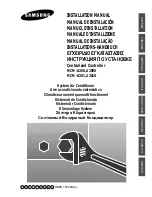
(©Aug, 2007)
FLAiR Series Installation, Operation & Maintenance Manual
Air Technology Systems, Inc.
2-17
2.8.6
Thermal Expansion Valve
FLAiR units utilize a thermal expansion valve (TEV) to
control the flow of refrigerant entering the evaporator
and maintain a constant superheat of the refrigerant
vapor at the outlet of the evaporator. Superheat is the
difference between the refrigerant vapor temperature
and its saturation temperature at a given suction
pressure. By controlling superheat, the TEV keeps
nearly the entire evaporator surface active while
preventing liquid refrigerant from returning to the
compressor. As a standard, superheat is factory set at
12-15°F and should not need adjustment.
2.8.7
Hot Gas Reheat (Optional)
The hot gas reheat option incorporates a hot gas
reheat solenoid valve and a hot gas reheat coil. Under
normal operation, when no reheat is required, the hot
gas reheat valve is de-energized and hot gas flows
directly from the compressor discharge to the con-
denser. When there is a call for reheat, the controller
energizes the hot gas reheat solenoid valve. The hot
gas reheat solenoid valve diverts hot gas to the reheat
coil, mounted directly downstream of the evaporator
coil, before it travels to the condenser. No adjustment
to the valve is necessary.
2.8.8
Hot Gas Bypass (Optional)
The two most common systems provided by SATS for
hot gas bypass are snap acting and full floating.
2.8.8.1
Snap Acting
The snap acting hot gas bypass system provides
some modulated capacity control and freeze protec-
tion. The hot gas bypass system includes a discharge
bypass valve that allows some hot gas from the
compressor discharge line to pass into the evaporator
coil in order to maintain a preset suction pressure.
The snap acting hot gas bypass system also provides
freeze protection for the evaporator coil by limiting the
minimum refrigerant pressure, thereby preventing the
surface temperature of the evaporator coil from drop-
ping below 32°F.
The normal control setting is 50-55 psig (suction
pressure) read from the suction (low) side of the
compressor as it operates in full hot gas bypass
operation. The valve is factory set and no adjustment
should be necessary. If adjustment is required, block
one half of the coil and remove adjustment cap from
the end of the valve. Using a 5/16 inch allen wrench,
turn clockwise to increase pressure or counterclock-
wise to lower pressure.
2.8.8.2
Full Floating
A full floating hot gas bypass system is provided for
split AHU/Remote Condensing Units. The full floating
hot gas bypass system may include a quench valve
and solenoid, a quench thermal expansion valve, a hot
gas (discharge) valve and solenoid and a hot gas
bypass valve.
The hot gas bypass valve allows refrigerant to flow from
the discharge line, directly to the suction line. The hot
gas bypass entering the suction side of the compres-
sor would raise the operating temperature of the
compressor to a point where failure could occur. To
prevent overheating the compressor, a small amount of
liquid refrigerant passes through the quench valve and
mixes with the hot gas entering the compressor,
maintaining normal compressor suction pressure and
temperature.
The full floating hot gas bypass system provides freeze
protection for the evaporator coil by limiting the
minimum refrigerant pressure, preventing the surface
temperature of the evaporator coil from dropping below
32°F. The hot gas (discharge) regulating valve has a
normal control setting at 50-55 psig (suction pressure)
read from the suction (low) side of the compressor as
it operates in full hot gas bypass operation. The valve
is factory set and no adjustment should be necessary.
If adjustment is required, remove the adjustment cap
from end of the valve. Using a 5/16 inch allen wrench,
turn clockwise to increase pressure or counterclock-
wise to lower pressure.
CAUTION
Do not exceed 20°F superheat. Exceeding this
temperature may cause failure of the compres-
sor.
The quench valve normal control setting is 20°F
superheat (when there is no call for cooling). The valve
is factory set and no adjustment should be necessary.
If adjustment is required, remove the adjustment cap
from the valve. Turn the adjusting stem clockwise to
increase the superheat and counterclockwise to
decrease the superheat.
Summary of Contents for FLAIR series
Page 1: ...FLAiR Series Installation Operation Maintenance Manual Aug 2007 Air Technology Systems Inc ...
Page 42: ... Aug 2007 FLAiR Series Installation Operation Maintenance Manual Air Technology Systems Inc ...
Page 44: ... Aug 2007 FLAiR Series Installation Operation Maintenance Manual Air Technology Systems Inc ...
Page 46: ... Aug 2007 FLAiR Series Installation Operation Maintenance Manual Air Technology Systems Inc ...
Page 48: ... Aug 2007 FLAiR Series Installation Operation Maintenance Manual Air Technology Systems Inc ...
















































